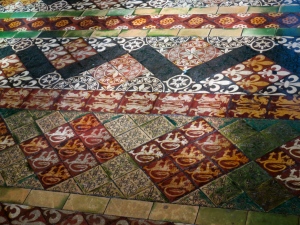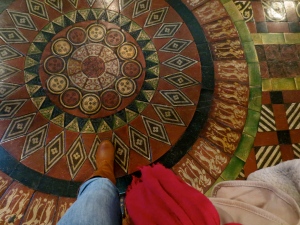I just couldn’t get over the floors, the tiled floors of Christ’s Church. Green, red, brown, black, yellow, and white tiles that cast back the light so strangely—softly, velveteen—that at first I thought they were some strange, hardened leather. The glaze had a mottled depth of color like old leather, and somehow this ceramic felt softer under my boots, but perhaps that was a deception of my first impression.
 The patterns changed with every step, sometimes wheels with different rings—concentric rows of people, griffons, knots, roses, crowns, fleur de lies—or diamonds, triangles, checkers, all tessellations of these same colors and figures. I expected them to repeat each other at some point, for some over all design or consistency to emerge. But I never quite found it. Trying to unravel them, I walked through the early gothic cathedral with my eyes to the floor.
The patterns changed with every step, sometimes wheels with different rings—concentric rows of people, griffons, knots, roses, crowns, fleur de lies—or diamonds, triangles, checkers, all tessellations of these same colors and figures. I expected them to repeat each other at some point, for some over all design or consistency to emerge. But I never quite found it. Trying to unravel them, I walked through the early gothic cathedral with my eyes to the floor.
I’d seen Gothic churches before, of course. When I went to Spain last summer every town had at least one Gothic church, or so it seemed. They were so common that my architecture professor delineated Early, Middle and Late Gothic, based on the arches, windows, design, use of color. He pointed out the baroque elements creeping in through frescoes and color, or the darker, crouching Romanesque elements from early construction. But all those churches, from the seventh century to the seventeenth, all had plain stone floors, sometimes with simple engravings or patterns to the pavers. Nothing to distract the upward gaze of the believer as the eyes slid up the columns to the capitals, the arches, the windows, pointing to vaulted ceilings, and through the mortared cracks to heaven. These intricate and endlessly looping tiles seemed counterproductive.
I tried, at first, to focus upwards, to sit in the rows of wooden chairs and look penitently towards the ceiling—as tourists and pilgrims around me did. But when I looked up, I noticed other things—the way the north wall bowed inward, severely, looking close to collapse. I wondered that the windows didn’t snap from strain. When I looked up, I noticed the extranal window-grates visible through the detailed glass. Thoughts of stone-throwing, fires and riots flickered and flared in my head. The legacy Irelands religious tumult? Legacy of this church as Catholic, then Anglican, then Catholic, then Anglican? I remembered those Spanish cathedrals, so obviously bearing the scars of their own conflicts, so obvious which windows remained and which were replaced. And those structures had always housed Catholic prayer, and they still bore scars.
And wasn’t I annoyed—be honest, Annie—that this church and its great sister, St. Patrick’s Cathedral, were Anglican? That founded, constructed, and celebrated as Catholic for hundreds of years, I couldn’t go to Mass in either? Didn’t I feel that, at least a little? Was that feeling allowed?
I immediately scolded myself—Anne Marie, grudging people their place of worship, the place that has been theirs too for hundreds of years is on the exact same spectrum as Jews who refuse to recognize the validity of the Dome of the Rock, or the Muslims who refuse to recognize Adyodhya as a Hindu shrine. Feelings you condemn in others. I have seen the results of these feelings—bullet holes in church walls, slanted pot marks gouged from the stone, armed guards at mosque gates, tall in their army green with rifles as long as my leg, angry graffiti, Death to Hindus, Death to Christians, Death to Muslims, contorted faces, shouting, yelling, screaming faces. Annie, you have seen these feelings. Feelings that sparked riots, bombings, shootings, wars. Death, Annie, those feelings sparked death and killing. Excise these feelings from your heart. They lead to nothing good.
But I still feel them, however faintly, and will continue to feel them—I think—so long as people try to tell me I do not have a stake in this place, or any other, because I am Catholic. My rejection of this Anglican place is a reaction to past rejection, a reaction to people telling me I cannot lay claim to this or that, because I am Catholic. How many atheists and agnostics have told me, though not in so many words—You cannot be tolerant, because you are a Catholic. You cannot respect women, because you are a Catholic. You cannot respect gay, lesbian, transgender, bisexual, or hell, even sexually active people, because you are Catholic. What did one friend tell me when I refused his romantic advances? “Yeah, I should have known a UU (Unitarian Universalist) and a Catholic would never work.” Translation: You cannot accept and love me, because you are Catholic. Words that knocked me back a step, or two.
And I feel those words in this church, in the bowed walls, in the barred, saint-colored glass, in the stones those bars guard against—You cannot worship here, because you are Catholic.
I must remember, now, that I set the parameters of my Catholicism. It is mine to define. That only in letting others reject me do I feel the need to reject them.
I’ll sit here in these simple wooden chairs, staring at these beautiful tiles that reflect the softness, the infinity, complexity, and un-know-ability of the divine more than these lancet ceilings above. I’ll stare at the ground and send out these thoughts: I am tolerant, and I am Catholic. I do respect women, and I am Catholic. I respect gay, lesbian, transgender, bisexual, divorced, Hindu, Jewish, Protestant, Muslim, Atheist, Unitarian Universalist people, rocks, plants, porpoises and platypuses, and I am Catholic. I can praise God in this place, and feel the power of the thousands who prayed before me, right here, and I am Catholic. I smooth these feelings of hurt and exclusion, of telling me what I am and am not, I smooth those words over with new ones. I stare at the floor, at the strange beauty of these tiles, and let the rest slip away.

